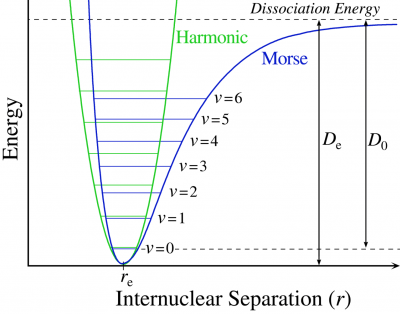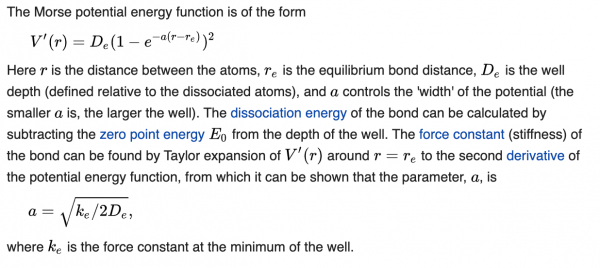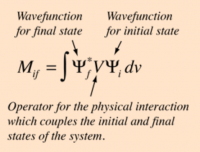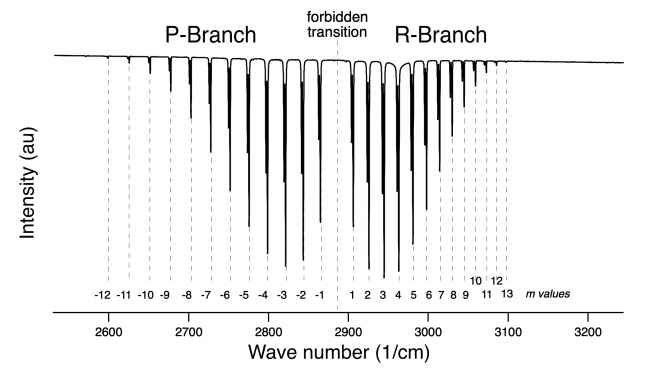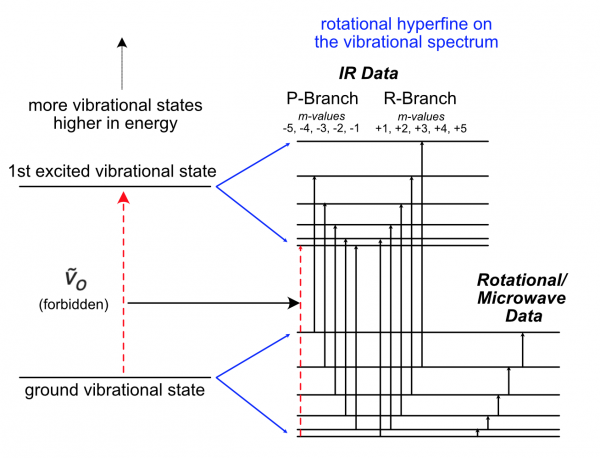PCh8 Lec2
Section 8.3 (cont.)
So, one of the things that we have not full acknowledged is that the harmonic oscillator potential of 1/kx2 is not really the actual potential...it is close, but not completely accurate. Figure 8.6 (similar to below) compares the 1/2kx2 potential to a potential referred to as the "Morse potential." The Morse potential is also referred to as an anharmonic potential. The Morse potential is one type of anharmonic potential, some fundamental research projects seek to refine the form of the "true" anharmonic potential.
If you recall originally solving the Schrodinger equation with the "harmonic" potential, the energy separation between the levels was the same, but with the Morse potential the energy result is slightly different leading to the energy levels getting closer together as we move up in the levels. Additionally, the harmonic potential did not acknowledge the fact that we can break the bond (the harmonic potential was infinitely high); the Morse potential takes bond breaking into account.
The following is taken from the "Morse potential wikipedia page", if interested, you could play with this function in Mathematica; manipulate "a"...
We can finish this section by looking closely at Table 8.3. Here is what you know:
- 1) the value for the ṽo (forbidden) is determined by the gas phase IR spectrum.
- 2) the value for the ν is calculated, ν = ṽo * speed of light in cm/sec.
- 3) xe is the equilibrium bond length that can be calculated from the IR data...you did this with HCl.
- 4) k is the force constant; you calculated this in last lecture using reduced mass and ṽo
- 5) B is the rotational constant you calculated using the IR data for HCl.
- 6) Do is listed in this table, but i am not sure how this was determined...sorry.
Section 8.4
Don't read this section (unless you want)...see this following comment:
This section is titled "Selection Rules" but it is really about transition probabilities or what governs whether a transition can occur between two states. As you should recall, we carried out some integrals associated with normalizing wave functions and also when we were discussing whether wavefunction were orthogonal or not.
Consider a system with only two energy levels. Each energy level has a wavefunction. If you want to know the whether the system can transition from one level to the other, then you can determine the probability of this occurring by taking the integral of the final state wavefunction * spectroscopic operator --> initial state wavefunctions over all space the wavefunctions exist.
probability of transition (~M)
You may have asked yourself why were the IR transition intensities different in the HCl IR spectrum; the answer lies in the details of population analysis and transition probabilities.
Section 8.5
Skim...
Section 8.6
Rotational Spectroscopy
READ...
So Monmouth College does not have a rotational spectrometer, but we are not alone. Rotational spectroscopy, or microwave spectroscopy is not a very common technique. As you saw with the HCl IR spectrum, we can get rotational information (B, and then r) out of a gas phase IR experiment. I will remind you that although we got rotational information out of the IR experiment, we never actually caused a transition between rotations state.
I want to discuss this HCl spectrum previously collected and an energy level diagram:
Question 1
Considering that the separation of the rotational energy levels is the same in all vibrational levels, can you calculate the rotational transition frequencies in 1H35Cl for the 5 rotational/microwave transitions shown in the diagram?
- Answer:
- - smallest value is [ν(m-value = +1) - ν(m-value = -1)]/2 = ~20 1/cm = 2B, so B=~10
- - next higher is [ν(m-value = +2) - ν(m-value = -2)]/2 = ~40 1/cm = 4B, so B=~10
- - next higher is [ν(m-value = +3) - ν(m-value = -3)]2 = ~60 1/cm = 6B, so B=~10
- - next higher is [ν(m-value = +4) - ν(m-value = -4)]/2 = ~80 1/cm = 8B, so B=~10
- - highest value is [ν(m-value = +5) - ν(m-value = -5)]/2 =~100 1/cm = 10B, so B=~10
- Average B = ? <-- this value should be very close to your determined value.
End of Chapter 8 material
